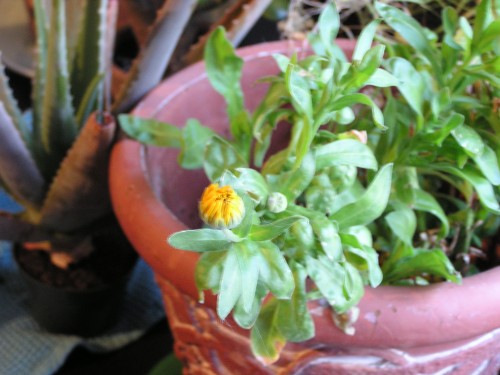by Briscoe White | Jan 10, 2012 | Herbs, Indoor Gardening, Inspiration, Miscellaneous, Recipes, Urban Gardening |
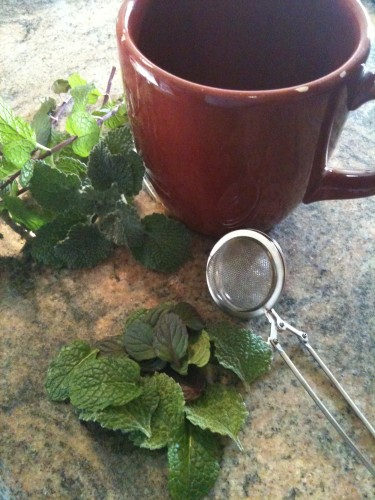
While winter is still flirting with us here in zone 7, many of our friends are already hunkered down throughout the country to weather out winter storms. Though I love the simple beauty of winter, I hate that freezing feeling. You know the one, where you can’t seem to ever get warm. The one that no matter how many layers of socks you put on, you still have toecicles. It’s that down-in-your-bones-cold feeling that no heap of blankets can seem to remedy. If you’re having trouble staying warm from the inside out, then it’s time to brew some delicious hot tea. There’s no quicker cure for this kind of coldness, than a steaming cup of herbal tea to lift your spirits, warm your bones and relax your mind. For an added benefit, try mixing medicinal herbs into your brew to ward off those worrisome winter sniffles.
Here’s a great recipe from our Marketing Director, Caroline, who usually uses her cats as a “mew”-lectric blanket, but when they’re not enough, she turns to a hot cup of herbal tea from her garden.
We’ve had a relatively mild winter here in the Richmond, VA area this year, so when we experienced our first cold day, it was a shock. I got home after a long commute in the cold, and I just couldn’t leave the January chill at the door. I turned the heat up and donned a sweater but still wasn’t satisfied with the temperature. After a quick survey of the kitchen, I realized that it must be time to grocery shop, because I was out of herbal tea. Instead of chattering any longer, I realized that because of the unseasonably warm winter we’d had until this point, I still had a few hardy herbs left in my gardens outside and some indoor potted herb gardens thriving in my kitchen.
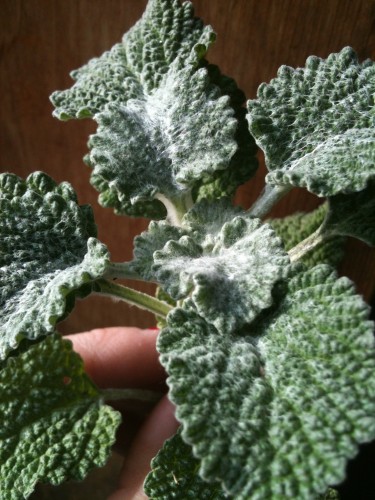
Younger Horehound leaves are covered in a protective fuzz that they shed as they grow bigger.
I gathered a handful of Horehound, an old fashioned medicinal herb, related to mint that acts as a soothing expectorant. Though not approved by the FDA you can find Horehound in many candies, cold remedies and lozenges, and makes a wonderful tea. (As with all medicinal herbs though, you should consult your doctor or herbalist if taking other medications and it shouldn’t be taken in large doses, especially by people with heart conditions or who may be pregnant because it may affect your blood pressure or existing heart conditions.) I think it’s a beautiful plant in the garden, with its fuzzy, textured leaves and was excited to try it in tea. I found it to be slightly on the bitter side, so next time I’m adding more Mint and maybe even some Stevia to sweeten it up!
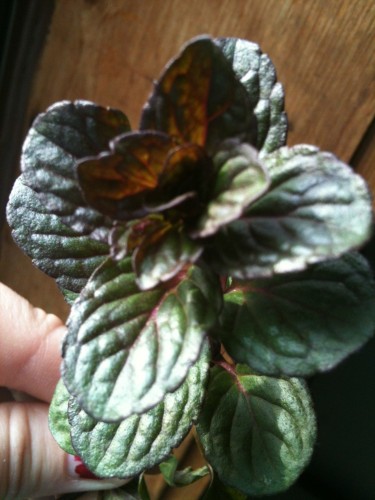
Chocolate Mint is a beautiful addition to your kitchen garden.
I also picked a few dark sprigs of Chocolate Mint and some large, bright green leaves of Kentucky Colonel Mint for flavor. Mint has always been one of my favorite plants- it’s easy to grow, easy to use, and each variety has its own charm. The smooth, dramatic leaves of the Chocolate Mint and the brilliantly green texture of the Kentucky Colonel Mint look as great in an herb bouquet as they taste in a tea! These two varieties are a unique twist on the standard Peppermint flavor. Kentucky Colonel has a bold, spicy spearmint taste that works well in summer drinks and salads. Chocolate Mint has a smoother, more subdued flavor, warmer than some of the other varieties, and tastes great in desserts. Both of these culinary herbs are perfect for making tea, as Mint is a great digestive aid and its strong mentholated aroma allows you to breathe more easily.
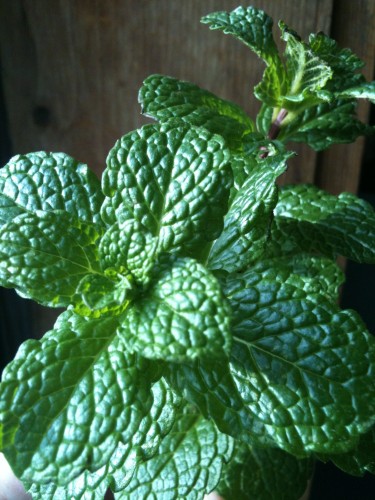
Kentucky Colonel Mint is great for more than just Mint Juleps!
Being too impatient to dry my herbs, I washed and chopped them and then packed them into a small tea infused. Just add hot water and let the leaves steep for a bit! You can also dry your herbs in advance for more of a traditional tea.
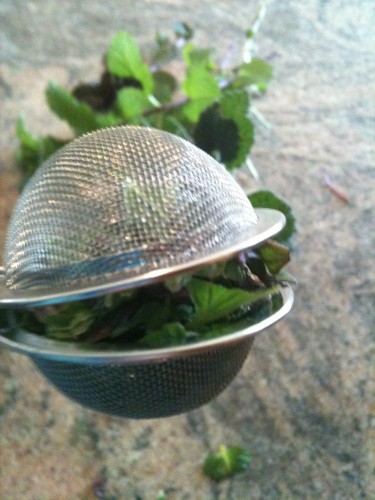
You can also use cheesecloth to make a small pouch for infusing.
Consider tisanes (herbs for making tea or herbal infusions) when you’re planning your next garden. We all love teas with more floral flavors, like Chamomile and Lavender, but don’t forget that many culinary herbs make a great tea, too. Some other unlikely candidates for a healthy, flavorful tea to warm your bones are Lemon Grass, Rosemary, Basil and Lemon Thyme. Try mixing different variations of your favorite culinary herbs and discover a delicious new way to use your garden! Want to get a start on your herb garden during these cold winter months? Try one of our Potted Herb Garden Kits, like our Time For Tea Gift Set and we’ll give you everything you need, from soil to saucer, to grow your own tea garden.
by Briscoe White | Jan 3, 2012 | Basics, Gardening, Growing, Herbs, Inspiration, Miscellaneous |
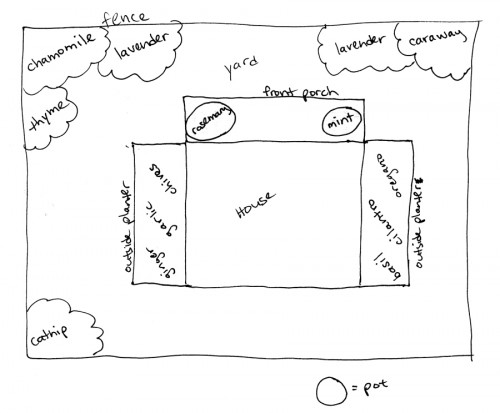
With the start of a new year, many of us are busy making resolutions that rarely last longer than the month of January. This year, in addition to the usual promises to save money, eat healthier and get more exercise, don’t forget to make resolutions for your garden. (Simply resolving to get outside and grow more this year will help satisfy those previously mentioned promises!) By investing your time into growing your own herbs and edibles and working hard to keep your garden successful, you’ll end up healthier, more fit and you’ll save some green by going green. Our blog series of three herb gardening resolutions will make keeping your other intentions for 2012 much easier and make sustainability more satisfying!
1. Plan Ahead
While we’re in the grips of winter and it’s too cold to garden outside, make the best use of this time by planning your spring garden! Being prepared is the best weapon in your gardening arsenal and doing a little research now will ensure for a more bountiful garden later. Make sure to determine what purpose your garden has, whether it may be for cooking, to attract wildlife, or to heal yourself from home. Once you’ve narrowed down how your garden will function, you can determine what and where to plant within its borders.
Purpose determines placement! For a culinary herb garden, you may want to plot a spot near your back door to keep fresh herbs just within arm’s reach for your favorite recipe. Where ever you decide to place your garden, whether you have boundless acres or a beautiful balcony, make sure that you get plenty of light, and you have fertile, well-draining soil for planting. You can also start indoor potted herb gardens over the winter to be transplanted into your outdoor space once the weather warms up. This will give you an early crop of your favorite spring herbs or veggies, and it’s a great project to keep you gardening over the winter.
While you’re stuck inside and curled up by the fire this winter, create a gardening journal to organize your thoughts. Jot down ideas, track the amount of sunlight each part of the garden gets, record interesting new plants and creative uses while you’re dreaming of spring, so you don’t forget these inspirations when spring hits.Sketch your plans for your garden and label where you’d like your plants to go. Drawing your garden out before breaking ground really helps, as it is much easier to erase a plant that doesn’t fit, than to dig it back up and transplant.
Just a little forethought really goes a long way, and a good garden depends on a thoughtful gardener. Stay tuned tomorrow for Part 2 of our 2012 Herb Garden Resolutions Series, when we discuss Companion Planting!
by Briscoe White | Dec 19, 2011 | Inspiration, Life on the Farm, Miscellaneous, Wildlife |
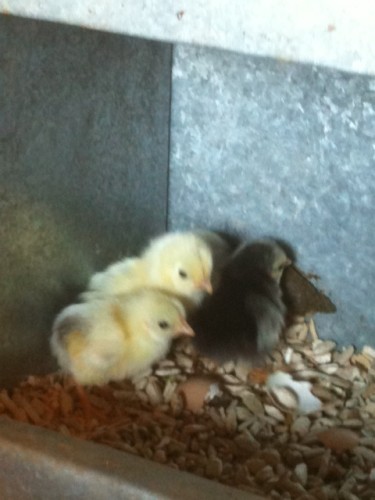
This time of year always feels magical to me- as if anything is possible. You can just feel it in the air- all of the goodwill, warm spirits and excitement- it feels like being a kid again, when everything felt full of wonder. I felt that same wonder when I walked into our chicken coop to gather eggs, and I found seven fuzzy little presents tucked below our two Columbian Rock hens. Though well out of season for hatching chicks, these two white and black hens have been anxiously sharing a nest, a process we call “dumping”. The two laid in the same nest, taking turns keeping the eggs warm. In warmer months when laying is more common, this can actually kill the chicks, as they get too warm with the dual body heat, but since we’ve been getting so cold at night here in zone 7, it was necessary for the chicks’ survival.
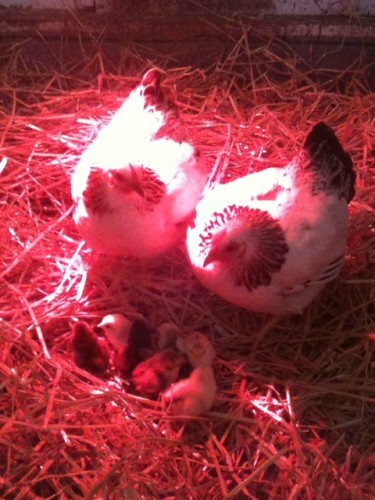
We leave the lights on in the coop at night to reschedule the hens’ natural cycle, encouraging them to lay eggs throughout the winter. When daylight hours begin to shorten, leaving the lights on for longer periods of time will stimulate the hens’ pituitary glands and trick them into continuously laying eggs. This doesn’t harm the chickens, and we get to enjoy fresh eggs all year round! Though this was a man-made miracle, we were still in awe that these little guys had hatched. I guess it was only a matter of time before our plucky little rooster was able to woo these two ladies, resulting in our newest little additions. I guess you just can’t stop nature’s agenda!
We love the Columbian Rocks because of their beautiful markings and small stature. Though we know we should have kept a closer eye on our randy rooster, the chicks will have a warm home in our brood house, which is filled with straw and heat lamps to keep them nice and cozy. Both mothers and the seven chicks are all doing great and enjoying all of the warmth and attention.
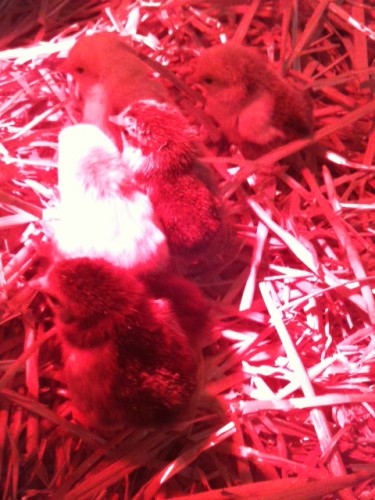
We hope that this season holds all of the awe and wonder for you and yours, that we felt upon finding these little guys this morning. I think that’s one of the best parts of this time of year, the childlike wonder that we all recall that allows us to pause and appreciate family and friends. From all of us to all of you, we hope you have a wonderfully warm holiday season, and keep your eyes open for everyday wonder!
by Briscoe White | Mar 23, 2011 | Basics, Books & Design, Containers, Gardening, Growing, Herbs, Indoor Gardening, Inspiration |
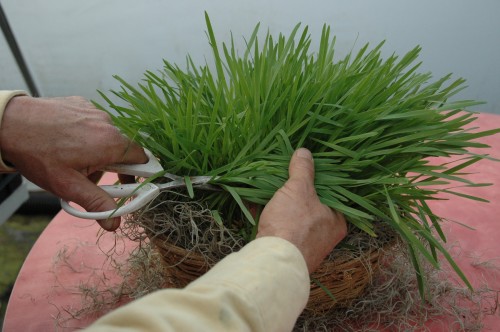
The grass in your Easter Basket, like the grass in your yard, will need periodic trims. When your grass grows to be about 9” tall, give it a little haircut by holding a clump of blades in one hand and trimming off the tops with pruning shears. Be sure to snip the flat part of the blade, not the more round part of the blade near the base. Periodic pruning will encourage the grass to reinvest its energy into growing stronger, and it helps keep your mini “lawn” in lovely shape. Continue to keep it in a nice sunny window and with frequent watering and regular pruning, your Easter grass will last you long after Peter Cottontail has hopped off down the bunny trail!
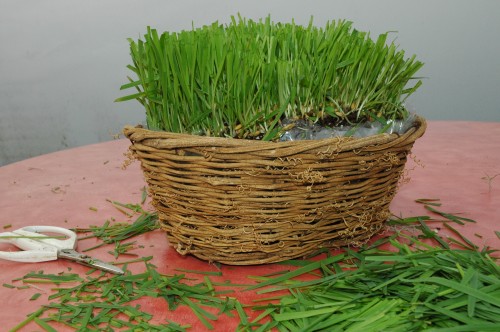
by Briscoe White | Mar 9, 2011 | Growing, Herbs, Inspiration, Miscellaneous |
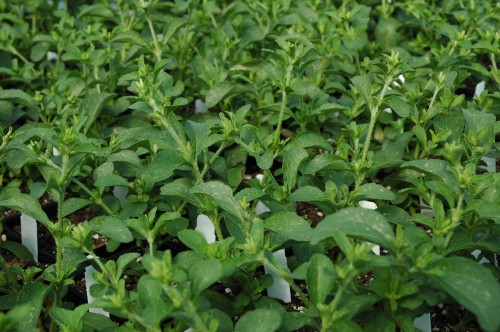
Looking to replace sugar in your life? Try Stevia! Stevia is an herb with a naturally occurring sweetness that is between 40 and 300 times sweeter than sugar (depending on the strength of the plant and the method by which its sweeteners are extracted). The natural sweetness is derived from the plant’s glycosides, which is called Stevioside. Stevioside is intensely sweet-tasting, doesn’t break down at high temperatures, is not a mutagenic and will not cause cancer in humans. Whether extracted in liquid form or found in powdered form as an alternative to table sugar, Stevia shows to be a very valuable plant for many healthy reasons. Calorie free, this herbal substitute to weight-causing white sugar is also safe for diabetics. Because Stevia does not raise blood sugar levels, it seems to be a great alternative to sugar for diabetics, but consultation with a medical professional is advised before altering your diet. Studies also show that Stevia does not promote tooth decay and that it may in fact help prevent plaque, according to research done at Purdue University. This sweet herb is also antibacterial and may aid patients who suffer from hypertension.
Although growing Stevia from seed is a trying process due to difficult germination and a scarcity of seed, growing Stevia from established plants and harvesting at home is a cinch! This shrubby herb is a tender perennial in warmer zones and will thrive in full sun. It prefers loamy, well-drained soil and needs to be kept moist but not saturated with water. It can grow up to eighteen inches high and does great in the garden or potted in a container for easier accessibility. Stevia can be a great culinary herb for flavoring drinks and dishes, but will not caramelize like sugar, so you may want to leave it out of your meringues and other dishes that require caramelization. Try growing some today and you can easily harvest the plant’s natural sweetener with the following method:
Harvesting Natural Sweetener from Stevia Plants
Materials:
2 Cups Fresh Stevia leaves, washed
1 Measuring Cup
Coffee Filters
1 Sauce Pan
1 Cup Grain Alcohol (You can use Vodka, Scotch, Brandy or whatever you prefer)
1 Strainer
1 Knife
1 Glass bowl
Preparation:
1) Chop the fresh Stevia leaves well to release the natural sweeteners. This will allow the leaves to more easily break down and for more of the plant’s sweetness to be extracted during the distillation process.
2) Allow the chopped leaves to steep in one cup of your preferred grain alcohol for twenty-four hours, in a covered glass bowl. Don’t worry. The alcohol will later be cooked out of the mix, but allowing the leaves to “bathe” in stiff spirits will separate the plant’s chemical components, removing the natural stevioside that we want.
3) After about twenty-four hours, strain the mixture through a strainer lined with coffee filters. This will remove and unwanted leaves and other plant materials, allowing only the herb’s extract and the alcohol to pass through.
4) Add the extracted concoction to your sauce pan and heat on low. Be sure not to simmer or boil your extract, as you want it to be hot enough only for most of the alcohol to evaporate out.
5) Once the majority of the alcohol burns off, your result is a concentrated extraction of the herb’s natural sweetener.
6) Make sure to dilute with water before using, as this is a concentrated form of Stevia that will be very sweet and may overwhelm your dish. Dilute with one part Stevia extract, to three parts water.
by Herb Exchange | Mar 3, 2011 | Basics, Containers, Flowers, Gardening, Growing, Herbs, Indoor Gardening, Inspiration, Miscellaneous, Urban Gardening |
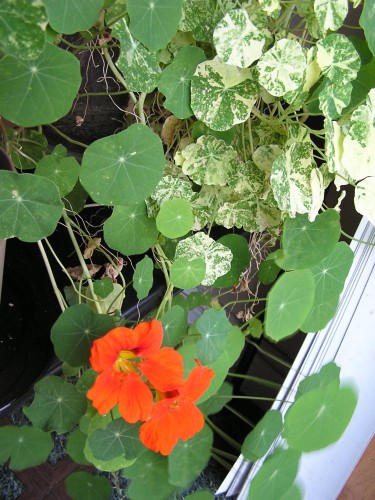
As some of you may have followed our previous blogs on our Social Media and Marketing Director, Caroline’s Nasturtiums, here’s an update on her indoor garden!…
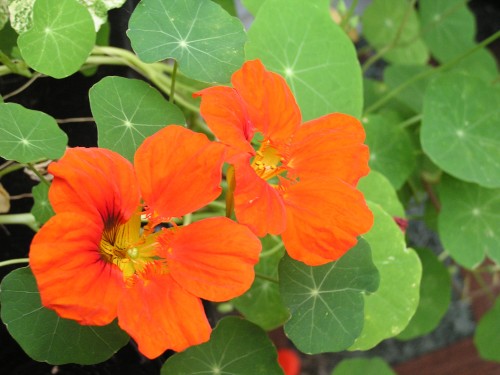
Those who know me, know that I’m a pack rat. I can’t stand to waste anything that has potential. This, coupled with my tendency to nurture, is what led me to my first attempt at indoor gardening, or, as I like to refer to it, my “Garden of Misfit Plants”. I’ve got annuals, succulents and houseplants cohabiting on an old card table that faces the sliding glass door to my backyard, that live in (general) harmony. Barring random attacks from our two nosy cats and the occasional neglected watering, my collection of crippled Cacti, Calendula and Nasturtiums have flourished in their new homes! After trials with recent repottings, I was excited to find that my ‘Empress of India’ Nasturtiums have begun to bloom yet again and my Calendulas are about to burst open in the next few days! These annual-turned-tender perennials have been such a great experiment in gardening–let’s see how long I can keep them going!
